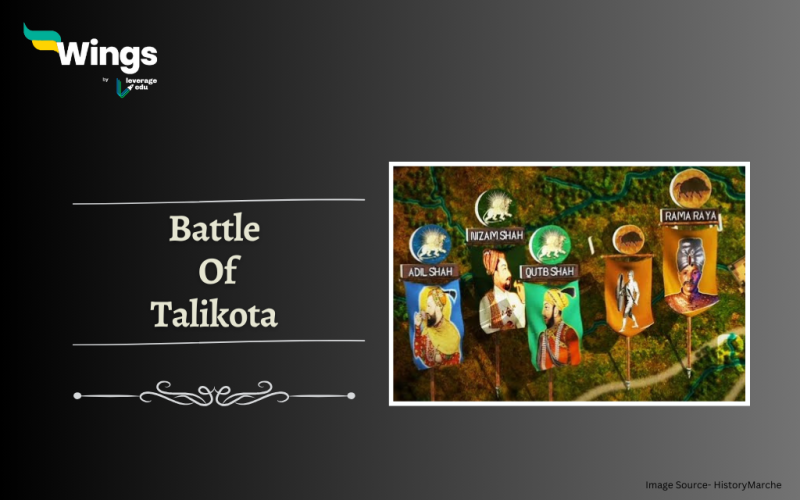The Battle of Talikota, also known as the Battle of Rakshasi-Tangadi. It was fought on 23rd January 1565, near the town of Talikota in present-day Karnataka. It was a turning point in South Indian history, leading to the collapse of the Vijayanagara Empire and the rise of the Deccan Sultanates. The battle was fought between the Sultans of Deccan and Vijaynagar Kingdom. Let us know more about the Battle of Talikota and what were the consequences of the battle.
| Battle of Talikota Overview | |
| Battle Took Place On | 23rd January 1565 |
| Place | Rakshasi-Tangadi |
| Fought Between | Deccan Sultanates Vs Vijaynagar Kingdom |
| Won By | Deccan Sultanates |
Background Of The Battle
In 1562-1563, Hussain Nizam Shah of Ahmednagar proposed to Ibrahim Qutb Shah of Golconda to marry Bibi Jamali, his daughter.
- As Kalyan was under the control of Adil Shah of Bijapur at that time, who had previously captured it from the Sultan of Bidar, they both agreed that the wedding should take place there.
- To maintain control over Kalyan, the four Muslim Sultanates united in January 1565, with at the centre – Ali Barid Shah I of Bidar, to the east – Ibrahim Quli Qutb Shah Wali of Golkonda, Hussain Nizam Shah I and Ali Adil Shah I of Ahmadnagar and Bijapur to the west, and launched an attack on Aliya Rama Raya.
- On the 23rd of January 1565, Rama Raya, the Vijaynagara Emperor, was also killed in the Battle of Talikota.
Also Read – Ashoka: The Great Ruler of the Mauryan Empire
Event Of The Battle
Sadasiva Raya who was the ruler of the Vijayanagar kingdom during the Battle of Talikota, but he was only a figurehead. The one who wielded real power was his minister, Rama Raya. Rama Raya made several attempts to weaken the Deccan sultanates by fomenting discord among them. However, the Sultanate learned of his plan and joined forces against the Vijayanagar kingdom. They attacked the kingdom, and upon entering the capital, they pillaged and destroyed everything in sight. There were several reasons that led to the occurrence of the “Battle of Talikota”.
- Historical records indicate that the “Deccan Sultanates” frequently attacked the kingdom of Vijayanagar.
- Another major reason for the war was to avenge Golkonda and Vijayanagar’s capture by Rama Raya.
- The “Deccan Sultanates” were also envious of Vijayanagar’s prosperity due to the fertile Doab regions.
- Finally, cultural and religious differences were also made of significant factors that led to the initiation of the “Battle of Talikota”.
- During the Battle, the Deccan sultanate used a cannon which was named “Malik-i-Maidan” which was offered by Ali Adil Shah I of the Sultanate of Bijapur. This cannon was the most important piece of cast bronze ordnance in the world at that time.
- After winning the battle, the Sultanate forces looted Vijayanagara without any resistance.
- Historians and archaeologists today advise against equating the state with the town due to the lack of information about the damage done outside of the Royal Center. They also emphasize that destruction and arson were politically strategic and aimed at sites connected to royal power, sovereignty and authority.
- Despite the lack of information about the damage done outside of the Royal Center, the conflict had a huge impact on Vijayanagara, resulting in a political split and a profound change in Deccan politics.
- The Vaishnava culture disappeared, and the patronage of various monuments and temples also stopped. The Royal Center still needs to be restored.
- Although their partnership was short-lived, the Sultanate of Bijapur was benefited the most from the conflict.
- After the conflict, Tirumala laid the foundation of the Aravidu dynasty, which further ruled over the remains of the former empire. The dynasty even did business for two years in Vijayanagara before moving towards Pengonda.
- The Sultanate of Bijapur moved towards the south before eventually being dissolving in the late 1640s because of successional disputes, and rebellions by several local ministers, primarily Telugu Nayak houses, who vehemently opposed the reemergence of any other central authority who had ongoing conflicts with them.
Also Read – Post Mauryan Period: Kingdoms, Cultures & Administration
Causes Of The Battle
The reason for Vijaynagar’s loss in the battle was due to having a smaller cavalry than the Deccan Sultanates.
- The Deccan Sultanate had more advanced weapons as compared to the Vijaynagar kingdom.
- The Deccan Sultanates also had superior expertise in artillery warfare.
- The major factor that led to Vijaynagar’s defeat was the disloyalty of two of their important commanders within the Vijaynagar kingdom, known as the Gilani brothers.
Relevant Blogs
This was all about the Battle of Talikota. For more content related to the different states of India, visit our articles like this, you can get Study notes on the Modern History of India here. Also, you can visit our general knowledge page on Indian History!
 One app for all your study abroad needs
One app for all your study abroad needs













